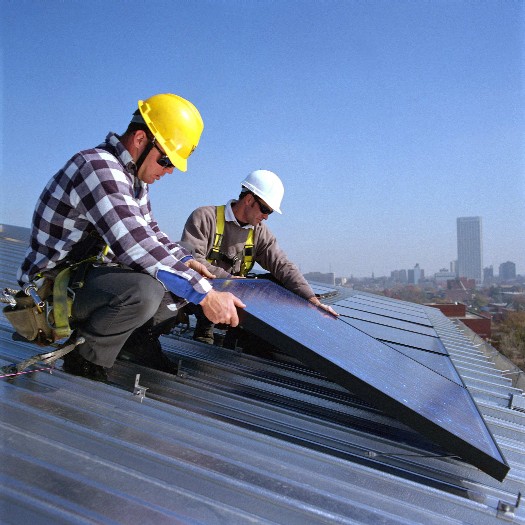To see the true value of rooftop solar we have to go beyond the figures [11 June 2013 | Peter Boyer]

Installing solar panels on a commercial rooftop. PHOTO econews.com.au
If there was only one country in the world ready-made for solar energy, it would have to be Australia.
We see a lot of the sun. Averaged across the country, a square metre of Australian land receives well over five kilowatt-hours of solar energy a day. Even Tasmania, for all its cloudy weather, gets about four kilowatt-hours a square metre.
To put Tasmania’s figure in perspective, it’s about on a par with the average in China and the US and well ahead of the UK, France and the global leader in installed solar panel systems, Germany, where ground-level solar energy is around three kilowatt-hours a day for each square metre.
We can harness solar energy by using its heat, as in solar hot water heaters, which have proven their worth for many a Tasmanian household. Concentrated solar electricity (“solar thermal”) is a large-scale use of the sun’s heat, which is used to boil water to drive a steam turbine.
But when most of us think solar, we think of arrays of grey panels on home rooftops. Photovoltaic solar — solar PV for short — is the technology now in use around the world for converting sunlight directly into electricity.
Solar PV has its detractors. One complaint is that Tasmania has below-average sunlight, which is easily dispelled by solar data. It’s been harder to counter the argument that it produces too little power for too much cost, but this scene is evolving rapidly.
Last year the US Department of Energy found that since PV went on the market in 1976 prices have declined by about 95 per cent — around 20 per cent for each doubling of the number of units installed. The first solar panels cost about $60 for each watt of power at maximum output; in 2010 panels cost just $2 per watt generated.
Predictions have proven spectacularly wrong. In 1996 the World Bank estimated that China would have 500 megawatts of solar PV by 2020, but China had doubled that mark by 2011. A prominent analyst’s 2002 predictions for the global PV market in 2010 turned out to be 17 times too small.
The trend shows no sign of slowing. The International Energy Agency says that annual growth of the PV market since 2002 is 50 per cent and rising. A huge increase in Chinese PV production has dropped prices to the point where prospective solar purchasers no longer need the carrot of a government subsidy.
Take-up of solar PV in Tasmania — around six per cent of all homes — has been lower than even the modest solar penetration elsewhere in the country. It’s most popular south of Hobart (the part of Tasmania farthest from the equator) and least popular in the northwest.
Solar PV has been said to be for rich people, but in Tasmania solar households are slightly below the median income. Energy consultant Chris Harries points out that while low-income places have very few rooftop systems (they can’t afford it), there’s a similar dearth in wealthy suburbs (there’s no money in it).
This is the backdrop for a fraught public debate in Tasmania about how much solar households should be paid for the electricity they export to the grid. Right now, and for three years to come, it’s the same as the retail rate for electricity from the grid — 27 cents per kilowatt-hour.
With the decreasing cost of installing solar, Treasury is effectively asking whether the feed-in tariff is now too high. The coming sale of Aurora prior to full retail competition has raised the prospect that the rate might drop to around 8 cents a kilowatt-hour, around the level in some other states.
Tasmania differs from other states in that its feed-in tariffs aren’t mandated by government regulation, protecting long-term investments, but are private agreements with Aurora Energy. A new energy retailer could unilaterally change the rate of payment for exported solar energy.
Solar advocates point out that a May 16 issues paper on feed-in tariffs wrongly assumes that power produced on site can be used to run “Tariff 41” devices such as water storage heaters. They say it badly over-estimates the percentage of PV power that is used by the household that generates it.
They also point to transmission savings from the rising amount of locally-generated and consumed electricity, or distributed energy — a significant contribution by solar PV to the network
Solar PV people “lack confidence in Treasury’s ability to understand the benefits to Tasmania of a growing solar industry,” says Jack Gilding, of the advocacy group Save Solar Tasmania.
“On all the available evidence, we expect Treasury to promote a very narrow view of the role of solar PV in our electricity system. The Minister has a responsibility to take into account the wider benefits to Tasmania of a vibrant decentralised electricity system.”
This is getting to the nub of the problem. Ordinary citizens have limited options in the battle to reduce emissions. For those who aren’t turned on by walking more or growing vegetables, generating renewable energy at home can be the way to get engaged with the low-carbon challenge.
Judging the solar PV feed-in tariff in purely financial terms is missing the main point. In our battle to cut emissions, actions count. They count not just because of their end impact, but because people need to feel empowered — to feel that they can make a difference.
Solar PV and solar hot water are two ways that average Tasmanians — and remember, the average income of people who install these systems is below the median — can reduce our consumption of grid electricity to free up more hydro power for export.
Tasmania’s political and administrative leaders need to take the big picture position on feed-in tariffs. The success of solar power matters to us all.
